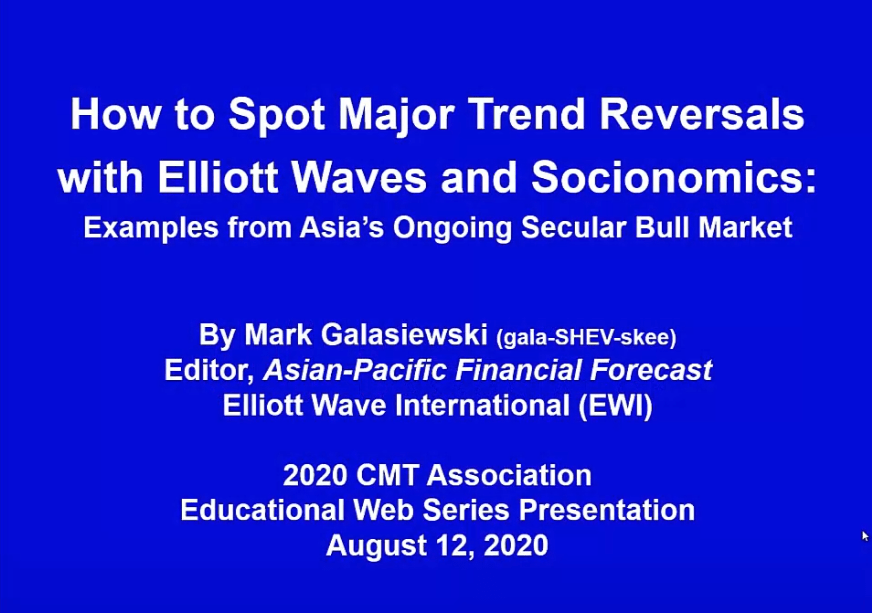 Letter from the Editor
Letter from the Editor
We had to add two more pages this month to fit all the content that we think you want and deserve as members of the Market Technicians Association. Technical analysis is a dynamic field and we all struggle to keep up with new developments. We read a lot of research and MTA news and as we prepare Technically Speaking each month, we struggle to fit in all the content that we would like to print while being constrained by our format limitations.
I am working closely with the MTA staff to find the best way to deliver high-quality content, and we want to make it more timely, as well. Our goal is to deliver more value for your membership, and the staff has been very responsive in trying to do this. Their efforts are not limited to the newsletter – they look to improve the organization and our benefits as they work for us every day. So we can’t say when we’ll have a solution, but as soon as possible we
To view this content you must be an active member of the TAN Association.
Not a member? Join the TAN Association and unlock access to hundreds of hours of written and video technical analysis content, including the Journal of Technical Analysis and the Video Archives. Learn more about Membership here.
What's Inside...
Bear Market Strategies; or, How I Learned to Stop Holding and Love the Death Cross
by Greg GazurianTraditionally, buy-and-hold investors have sought to buy low and sell high to maximize their returns. Although this sounds attractive, there are several problems with using only this approach to the...
Letter from the Regions Chair
by David Keller, CMTIn a period of incredible financial turmoil, the local MTA chapter meeting can provide you with two essential benefits: hearing from some of the best and brightest experts in our field, and...
Quantitatively Speaking
by Richard TortorielloOf all investing disciplines, technical analysis should be the most amenable to quantitative research. I define quantitative research simply as the use of a computer and a database to identify...
A Book Review: Quantitative Strategies for Achieving Alpha by Richard Tortoriello
by Richard Tortoriello & Michael Carr, CMTRichard Tortoriello leaves no stone unturned in a thoroughly documented search for strategies that allow portfolio managers to deliver market-beating returns. He begins with a short summary of his...
On the Campus
by Katie Stockton, CMTIn the eleven years that I have been a practicing technical analyst, acceptance of technical research as a viable tool for investing has increased dramatically. This is heartening because it has...
2009 Charles H. Dow Award Competition
by George A. Schade, Jr., CMTThe competition for the 2009 Charles H. Dow Award is open. The Award for excellence and creativity in technical analysis has been presented since 1994, and today is the most significant writing...
The Importance of Mid-Term Year Lows
by Paul Shread, CMTMuch has been made of the extraordinary stock market gains that have historically followed mid-term election year lows, but not nearly enough has been made of the importance of the lows...
Traditionally, buy-and-hold investors have sought to buy low and sell high to maximize their returns. Although this sounds attractive, there are several problems with using only this approach to the stock market. One of the most common issues is the notorious “round trip”, where the investor buys the stock at a relatively low price, holds the stock as it goes up and then continues to hold as the stock loses the gains until it returns to the price at which it was bought. Unfortunately, many investors have found themselves still holding after the gains disappear and losses continue, hoping the stock will make a comeback rally. Some buy even more, regardless of the losses they are still holding, in a feeble attempt to offset the losses by buying when it’s “really cheap”. This type of averaging down happens when emotions overtake logic and is usually for the worst.
Look at how
To view this content you must be an active member of the TAN Association.
Not a member? Join the TAN Association and unlock access to hundreds of hours of written and video technical analysis content, including the Journal of Technical Analysis and the Video Archives. Learn more about Membership here.
Contributor(s)

Greg Gazurian
Greg Gazurian has been trading stocks and options since 1998. He is an MTA affiliate from the Philadelphia Chapter, has completed level I of the CMT exam program. Greg worked over 9 years in IT for SunGard’s Market Data Services and CSA groups. Currently, he is seeking a...
In a period of incredible financial turmoil, the local MTA chapter meeting can provide you with two essential benefits: hearing from some of the best and brightest experts in our field, and networking with other technical analysis professionals in your immediate area.
Due to the hard work of many of the chapter chairs, the local meetings are seeing strong attendance and a growing interest from the investment community. I’d like to specifically recognize Sean Kolloff and Tom Talashek for giving new life and energy to the Boston and Chicago chapters, as well as Carson Dahlberg and Craig Fullen for managing a successful launch for the Charlotte and Columbus chapters. They have focused their time and energy on building out our organization, and we should all be appreciative of what they have done.
We are using more technology in the local meetings than ever before. We have successfully linked five chapters via webcasts
To view this content you must be an active member of the TAN Association.
Not a member? Join the TAN Association and unlock access to hundreds of hours of written and video technical analysis content, including the Journal of Technical Analysis and the Video Archives. Learn more about Membership here.
Contributor(s)

David Keller, CMT
David Keller, CMT is Chief Market Strategist at StockCharts.com, where he helps investors minimize behavioral biases through technical analysis. He is a frequent host on StockCharts TV, and he relates mindfulness techniques to investor decision making in his blog, The Mindful...
Of all investing disciplines, technical analysis should be the most amenable to quantitative research. I define quantitative research simply as the use of a computer and a database to identify investment factors that have historically been predictive of future excess returns (or returns above a market benchmark). Technical analysts rely on historical price and volume patterns to predict future price movement. Applying a computer to this task seems natural, and to the uninformed might seem easy.
In practice, however, much of technical analysis is an art, as is all else in the field of investment. A price pattern that works under one set of conditions may not work under another. What is easy for the eye and the brain to identify—a head and shoulders top, for example—can be very difficult to translate into computer code.
However, certain technical factors are relatively simple to model quantitatively. In this article, I’ll present a couple
To view this content you must be an active member of the TAN Association.
Not a member? Join the TAN Association and unlock access to hundreds of hours of written and video technical analysis content, including the Journal of Technical Analysis and the Video Archives. Learn more about Membership here.
Contributor(s)

Richard Tortoriello
Richard Tortoriello is the aerospace and defense analyst in the equity research division of Standard & Poor’s and has also conducted numerous quantitative investment studies for the company. He is responsible for buy, sell, and hold recommendations on twenty-five aerospace...

Richard Tortoriello leaves no stone unturned in a thoroughly documented search for strategies that allow portfolio managers to deliver market-beating returns. He begins with a short summary of his investing philosophy, illustrated in the first figure of the book and reproduced below.

When first presented in a Standard & Poor’s research report, he wrote: “We believe that, given the complexity of the financial markets, an analytical approach that integrates the three disciplines may yield superior insights and investment decisions:
- Fundamental analysis provides the important hypotheses about economic, industry, and company-specific trends, upon which good investment decisions are made.
- Quantitative analysis allows the investor to take a wide-angle view of a variety of fundamental trends that might otherwise be difficult to encompass. Figure 1.1 Fundamental, Quantitative, and Technical Analysis
- Technical
To view this content you must be an active member of the TAN Association.
Not a member? Join the TAN Association and unlock access to hundreds of hours of written and video technical analysis content, including the Journal of Technical Analysis and the Video Archives. Learn more about Membership here.
Contributor(s)

Richard Tortoriello
Richard Tortoriello is the aerospace and defense analyst in the equity research division of Standard & Poor’s and has also conducted numerous quantitative investment studies for the company. He is responsible for buy, sell, and hold recommendations on twenty-five aerospace...

Michael Carr, CMT
Mike Carr, who holds a Chartered Market Technician (CMT) designation, is a full-time trader and contributing editor for Banyan Hill Publishing, a leading investment newsletter service. He is an instructor at the New York Institute of Finance and a contributor to various...
In the eleven years that I have been a practicing technical analyst, acceptance of technical research as a viable tool for investing has increased dramatically. This is heartening because it has largely been driven by strong efforts from the Market Technicians Association and its affiliates.
In 2004, the MTA’s efforts were acknowledged by the SEC in their allowing Chartered Market Technicians to use their designation as an exemption from the Series 86 exam administered to publishing analysts. This not only benefited me directly by giving me added credibility as Chief Market Technician for my firm MKM Partners LLC, but also made me proud that my profession had gone from being considered voodoo by some to being considered respectable by many.
My career in technical analysis started even before I graduated from college. I was fortunate enough to be a student at the University of Richmond’s undergraduate business school, which pioneered a program
To view this content you must be an active member of the TAN Association.
Not a member? Join the TAN Association and unlock access to hundreds of hours of written and video technical analysis content, including the Journal of Technical Analysis and the Video Archives. Learn more about Membership here.
Contributor(s)

Katie Stockton, CMT
Katie Stockton, CMT, is Founder and Managing Partner of Fairlead Strategies, LLC, an independent research provider focused on technical analysis. Prior to forming Fairlead Strategies, Katie spent more than 20 years on Wall Street providing technical research and advice to...
The competition for the 2009 Charles H. Dow Award is open. The Award for excellence and creativity in technical analysis has been presented since 1994, and today is the most significant writing competition in the field. The recipients of the Award are among the most notable market technicians. The success of the Award has resulted in an enhanced cash prize.
The winning author will receive a cash prize of $4,000.00 and will be invited to present their paper at an MTA seminar or chapter meeting. The paper or a summary may be published in the MTA’s Journal of Technical Analysis, Technically Speaking newsletter, and posted to mta.org. At the discretion of the judging panel, the authors of runner-up papers will receive certificates.
The last day to submit papers is February 6, 2009, and the winner will be selected on or before May 8, 2009. The 2009 guidelines (below) and copies of all
To view this content you must be an active member of the TAN Association.
Not a member? Join the TAN Association and unlock access to hundreds of hours of written and video technical analysis content, including the Journal of Technical Analysis and the Video Archives. Learn more about Membership here.
Contributor(s)

George A. Schade, Jr., CMT
George A. Schade, Jr., who holds a Chartered Market Technician (CMT) designation, has written extensively about the people and innovations that have advanced the field of technical analysis within financial markets. A member of the TAN Association since 1987, he has written...
Much has been made of the extraordinary stock market gains that have historically followed mid-term election year lows, but not nearly enough has been made of the importance of the lows themselves.
So with that, I offer an observation on mid-term election year lows – and a possible explanation that is deeply relevant both to current market action and the future of the economy.
Since 1934 (basis DJIA), mid-term election year lows have held until the next mid-term low four years later, and if broken decisively, broken only at the end of the next four-year cycle low (1970, 1974, 2002). 1947-1949 saw multiple tests and even a breach or two of the 1946 low, but it essentially held. The 1987 crash came nowhere near the 1986 low, which was set at the start of the year, but found support near the bottom of a large consolidation that occupied the market for much
To view this content you must be an active member of the TAN Association.
Not a member? Join the TAN Association and unlock access to hundreds of hours of written and video technical analysis content, including the Journal of Technical Analysis and the Video Archives. Learn more about Membership here.
Contributor(s)

Paul Shread, CMT
Paul Shread, CMT, is co-author of "Dow Theory Unplugged: Charles Dow's Original Editorials and Their Relevance Today" (W&A Publishing,
New Educational Content This Month
-
August 26, 2020
The CMT Experience
Presenter(s): Tyler Wood, Dave Lundgren, CMT, CFA
-
August 26, 2020
Reading the Current Market in Light of History’s Lessons
Presenter(s): Ryan Detrick, CMT
-
August 12, 2020
How to Spot Major Trend Reversals with Elliott Waves and Socionomics: Examples from Asia’s Ongoing Secular Bull Market
Presenter(s): Mark Galasiewski



